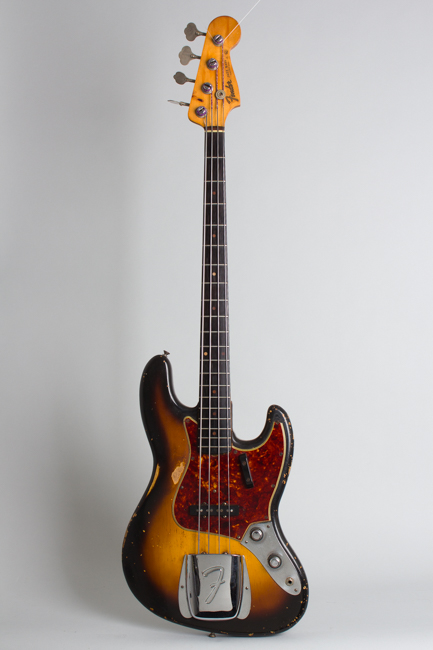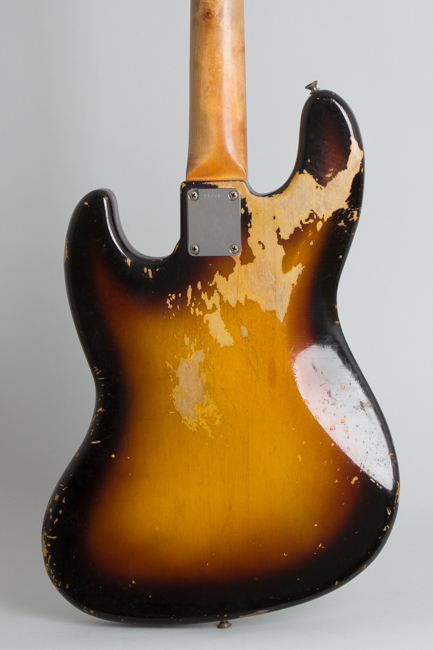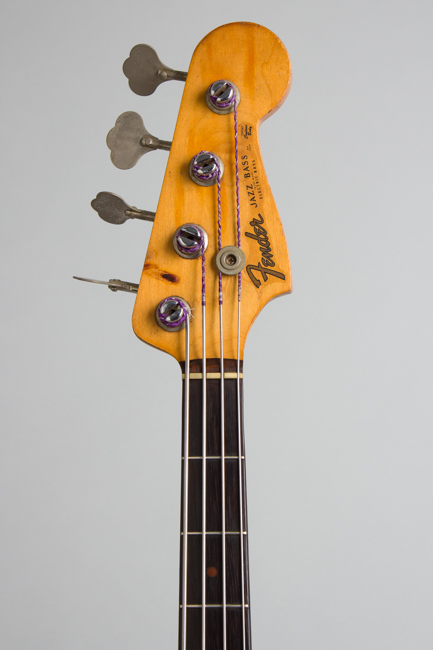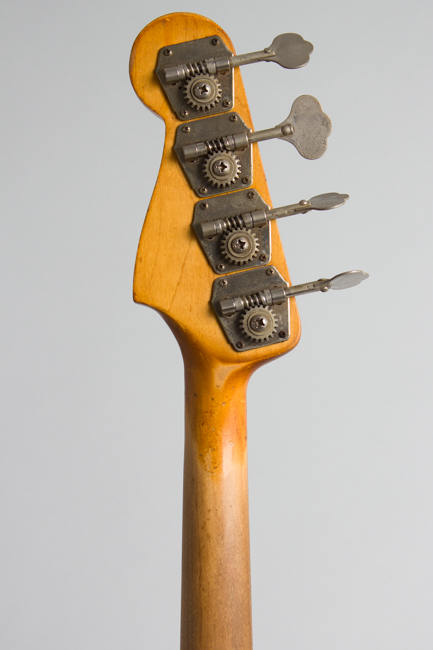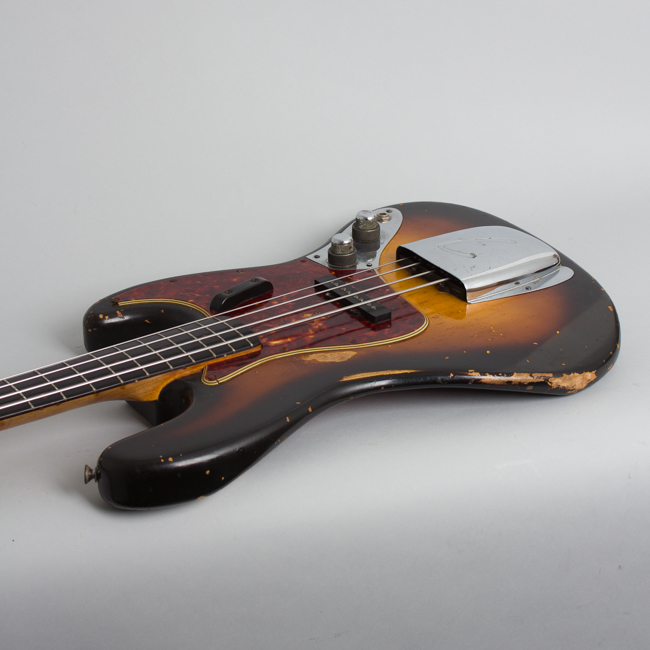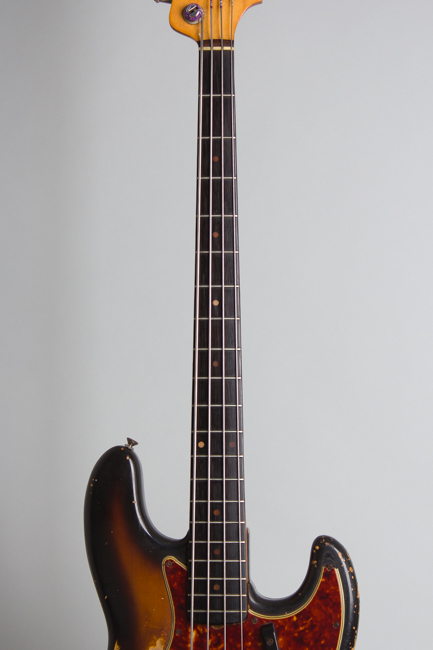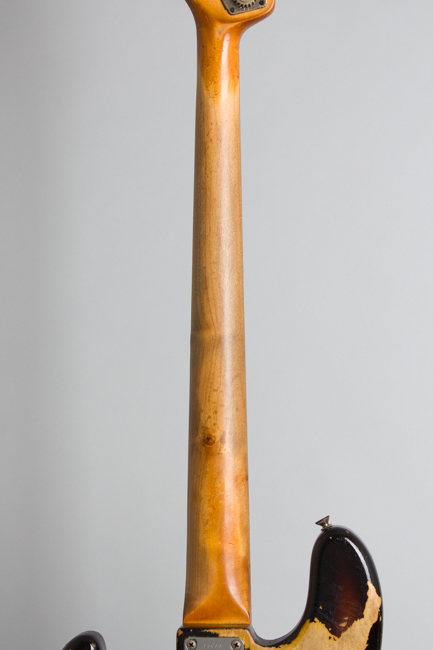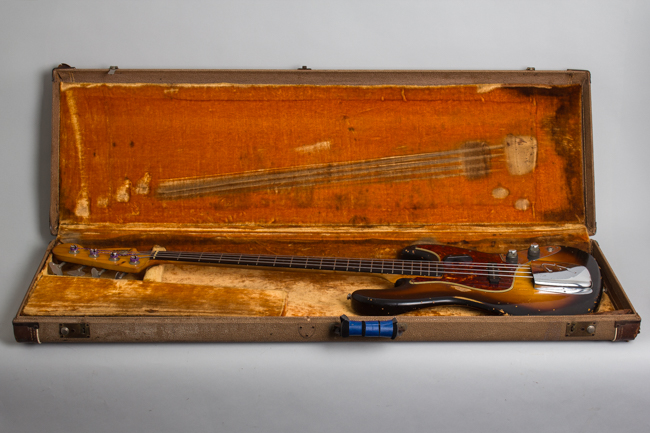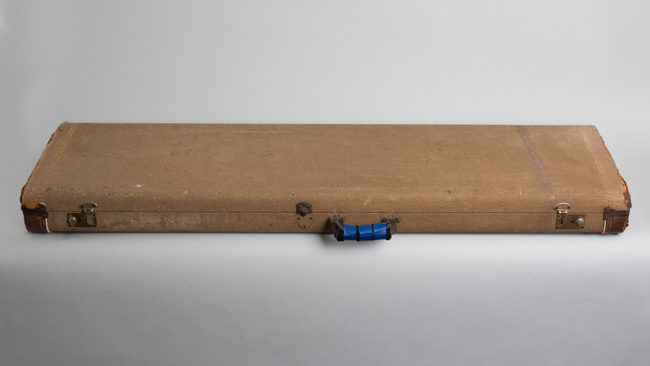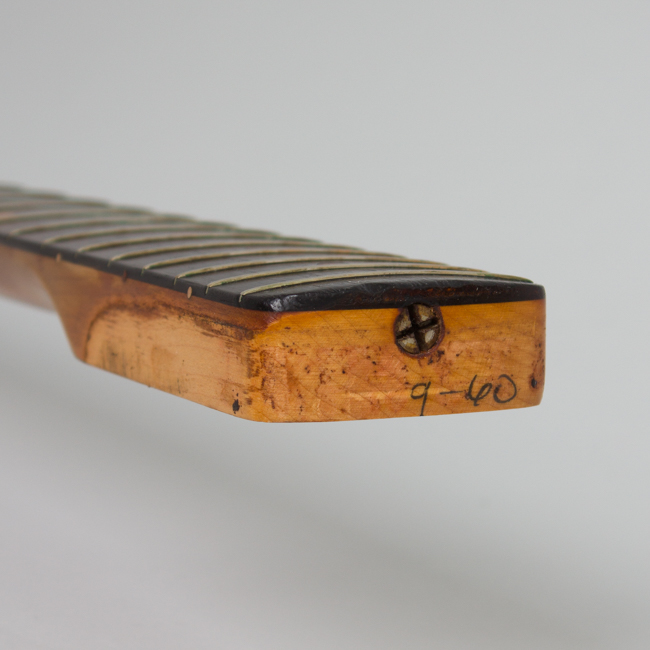Fender Jazz Bass Solid Body Electric Bass Guitar (1960)
Fender Jazz Bass Model Solid Body Electric Bass Guitar (1960), made in Fullerton, California, serial # 55035, sunburst lacquer finish, alder body, maple neck with rosewood fingerboard, original brown tolex hard shell case.
Folks, they don't come much more "Real Relic" than this. This wonderful feeling and sounding very early "stack-knob" Jazz Bass has been endlessly gigged but remains in amazingly all original condition, simply PLAYED for decades. The neck heel is marked 9-60 in pencil, the special two-on-one pots are stamped 25th and 39th weeks of 1960. This bass has all the hallmarks the characteristic of the '60 "Stack" including the very slim tapered neck, the individual string mutes and outside metal grounding strip (under the tailpiece cover) . The clay dot, slab rosewood fingerboard neck is exquisitely comfortable, worn to smooth wood by endless play time.
The 1960 introduction of the Jazz Bass represented a major step for Fender, and the electric bass in general. The Precision Bass had been on the market for about eight years and Fender was seeing increasing competition in a market they had created. The Jazz Bass was designed as an upgrade, the "Cadillac" of the electric bass world. With the sleeker offset body adapted from the Jazzmaster and a much slimmer 1 1/2" nut width, it had a racier look and sleeker feel than the Precision. The two slimmer-cased, multi-pole pickups offered a wider range of sounds, with a sharper attack and more definition to the tone.
The first samples of Fender's new bass appeared in the spring of 1960; it was added to the July '60 price list. As was typical for Fender large scale production of the new model began in the fall; the 9-60 neck on this bass marks it as one of the first full production batch as Fender geared up into fall activity after the July NAMM show. The Jazz Bass initially listed at $279.50 (plus case) which was $50 higher than the Precision. The more expensive instrument took time to catch on, and the earliest examples like this one are noticeably rarer than period Precision basses.
This bass looks to have been played for a lifetime, and with good reason. Perfectly balanced, this Jazz Bass has a very well defined, singing sound with loads of character. Even heavily worn this bass avoided being stripped to "hippie wood" in the '70s when that was considered the cool thing to do. The very resonant alder body still carries the what survives of the original well faded sunburst finish; it actually looks close to a 1957 two-tone. The pickguard is a very attractive mottled tortoise celluloid, typical of this period. This is one of the coolest "Real Relic" Fender basses we have had in a long time and carries a serious vibe for any Jaco fan, vintage-styled bass player or classic Fender bass connoisseur.
Overall length is 46 in. (116.8 cm.), 14 in. (35.6 cm.) wide at lower bout, and 1 5/8 in. (4.1 cm.) in depth, measured at side of rim. Scale length is 34 in. (864 mm.). Width of nut is 1 1/2 in. (38 mm.)., 9.07 lbs.
This bass is obviously extremely well worn overall, heavily used but not abused and remains an exceptionally fine playing and sounding instrument that really shows why these have been considered the cream of all Fender basses for decades now.
There is wear basically everywhere on the instrument but no added overspray, repairs or alterations. A few small spots were touched up along the body edges before someone gave up long ago. The face has numerous dings and dents with dirt and finger wear into the wood above the pickguard. The back of the body has many dings and scrapes and several large spots of buckle wear, the edges endless dings and dents. There is a lot of accumulated schmutz under tailpiece cover; the sprung felt mutes are long gone (one is still in the case) and a small piece of ancient foam is stuck to the bridge base. The original bridge itself is quite clean; the large chrome cover was likely in place for much of the instrument's life, as indeed it still is. Even the special flat-bottom screws securing it and the control plate are intact.
The back of the neck is almost completely worn down to the wood and heavily smoked in places on the heel and headstock. There is a small knothole flaw in the back of the maple neck somewhat surprising for Fender's top-end product, but this is the second 9-60 neck we have seen like this. The thick slab rosewood fingerboard is not heavily worn, although the dots have gone quite dark and are worn into a bit.
The all-important pickups and electronics remain completely original and complete, as does all hardware except the forward chrome pickup cover. The pickguard has some typical shrinkage and is missing the lower front corner, with the upper cracked but still in place. There is a finger divot in the guard above the E string. The headstock decal is dirty but intact, with one small flake off the "F" on Fender. There is a "classic" cigarette burn between the E and A tuner barrels. Amazingly the original small-wire frets are still intact with only minor wear; this bass must have been played with flatwound strings for most or all of its life.
All the artificial "relicing" in the world will never come close to re-creating the look and feel of this bass. It plays simply effortlessly and had a sound for the ages, strung with LaBella's new "Olinto" Flats which we find a particularly nice match for these early Jazz basses. The 1970s Nylon-Dipped Fender strings it came in with are also included in the pocket of the VERY well-worn original Brown HSC, which is missing two of the three latches but remains useful for storage and cool factor at least. These first 'Stack-knobs" have been highly sought for decades; in the 1980s many of them went overseas. This one was working away feeding someone's family, and now is ready for a new home. Overall Very Good + Condition.
Folks, they don't come much more "Real Relic" than this. This wonderful feeling and sounding very early "stack-knob" Jazz Bass has been endlessly gigged but remains in amazingly all original condition, simply PLAYED for decades. The neck heel is marked 9-60 in pencil, the special two-on-one pots are stamped 25th and 39th weeks of 1960. This bass has all the hallmarks the characteristic of the '60 "Stack" including the very slim tapered neck, the individual string mutes and outside metal grounding strip (under the tailpiece cover) . The clay dot, slab rosewood fingerboard neck is exquisitely comfortable, worn to smooth wood by endless play time.
The 1960 introduction of the Jazz Bass represented a major step for Fender, and the electric bass in general. The Precision Bass had been on the market for about eight years and Fender was seeing increasing competition in a market they had created. The Jazz Bass was designed as an upgrade, the "Cadillac" of the electric bass world. With the sleeker offset body adapted from the Jazzmaster and a much slimmer 1 1/2" nut width, it had a racier look and sleeker feel than the Precision. The two slimmer-cased, multi-pole pickups offered a wider range of sounds, with a sharper attack and more definition to the tone.
The first samples of Fender's new bass appeared in the spring of 1960; it was added to the July '60 price list. As was typical for Fender large scale production of the new model began in the fall; the 9-60 neck on this bass marks it as one of the first full production batch as Fender geared up into fall activity after the July NAMM show. The Jazz Bass initially listed at $279.50 (plus case) which was $50 higher than the Precision. The more expensive instrument took time to catch on, and the earliest examples like this one are noticeably rarer than period Precision basses.
This bass looks to have been played for a lifetime, and with good reason. Perfectly balanced, this Jazz Bass has a very well defined, singing sound with loads of character. Even heavily worn this bass avoided being stripped to "hippie wood" in the '70s when that was considered the cool thing to do. The very resonant alder body still carries the what survives of the original well faded sunburst finish; it actually looks close to a 1957 two-tone. The pickguard is a very attractive mottled tortoise celluloid, typical of this period. This is one of the coolest "Real Relic" Fender basses we have had in a long time and carries a serious vibe for any Jaco fan, vintage-styled bass player or classic Fender bass connoisseur.
Overall length is 46 in. (116.8 cm.), 14 in. (35.6 cm.) wide at lower bout, and 1 5/8 in. (4.1 cm.) in depth, measured at side of rim. Scale length is 34 in. (864 mm.). Width of nut is 1 1/2 in. (38 mm.)., 9.07 lbs.
This bass is obviously extremely well worn overall, heavily used but not abused and remains an exceptionally fine playing and sounding instrument that really shows why these have been considered the cream of all Fender basses for decades now.
There is wear basically everywhere on the instrument but no added overspray, repairs or alterations. A few small spots were touched up along the body edges before someone gave up long ago. The face has numerous dings and dents with dirt and finger wear into the wood above the pickguard. The back of the body has many dings and scrapes and several large spots of buckle wear, the edges endless dings and dents. There is a lot of accumulated schmutz under tailpiece cover; the sprung felt mutes are long gone (one is still in the case) and a small piece of ancient foam is stuck to the bridge base. The original bridge itself is quite clean; the large chrome cover was likely in place for much of the instrument's life, as indeed it still is. Even the special flat-bottom screws securing it and the control plate are intact.
The back of the neck is almost completely worn down to the wood and heavily smoked in places on the heel and headstock. There is a small knothole flaw in the back of the maple neck somewhat surprising for Fender's top-end product, but this is the second 9-60 neck we have seen like this. The thick slab rosewood fingerboard is not heavily worn, although the dots have gone quite dark and are worn into a bit.
The all-important pickups and electronics remain completely original and complete, as does all hardware except the forward chrome pickup cover. The pickguard has some typical shrinkage and is missing the lower front corner, with the upper cracked but still in place. There is a finger divot in the guard above the E string. The headstock decal is dirty but intact, with one small flake off the "F" on Fender. There is a "classic" cigarette burn between the E and A tuner barrels. Amazingly the original small-wire frets are still intact with only minor wear; this bass must have been played with flatwound strings for most or all of its life.
All the artificial "relicing" in the world will never come close to re-creating the look and feel of this bass. It plays simply effortlessly and had a sound for the ages, strung with LaBella's new "Olinto" Flats which we find a particularly nice match for these early Jazz basses. The 1970s Nylon-Dipped Fender strings it came in with are also included in the pocket of the VERY well-worn original Brown HSC, which is missing two of the three latches but remains useful for storage and cool factor at least. These first 'Stack-knobs" have been highly sought for decades; in the 1980s many of them went overseas. This one was working away feeding someone's family, and now is ready for a new home. Overall Very Good + Condition.
